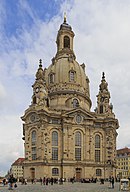Germany
Coordinates: 51°N 9°E| Federal Republic of Germany |
|
|---|---|

Location of Germany (dark green)
|
|

Location of Germany in the World
|
|
| Capital and largest city |
Berlin[c] 52°31′N 13°23′E |
| Official language and national language |
German[1][d] |
| Ethnic groups (2016[2]) | |
| Religion |
|
| Demonym | German |
| Government | Federal constitutional parliamentary republic |
| Frank-Walter Steinmeier | |
| Angela Merkel | |
| Wolfgang Schäuble | |
| Michael Müller | |
| Andreas Voßkuhle | |
| Legislature | |
| Bundesrat | |
| Bundestag | |
| Area | |
|
• Total
|
357,168 km2 (137,903 sq mi) (62nd) |
| Population | |
|
• 2017 estimate
|
|
|
• Density
|
232/km2 (600.9/sq mi) (58th) |
| GDP (PPP) | 2018 estimate |
|
• Total
|
$4.374 trillion[5] (5th) |
|
• Per capita
|
$52,801[5] (18th) |
| GDP (nominal) | 2018 estimate |
|
• Total
|
$4.212 trillion[5] (4th) |
|
• Per capita
|
$50,842[5] (17th) |
| Gini (2016) | low |
| HDI (2015) | very high · 4th |
| Currency | Euro (€) (EUR) |
| Time zone | CET (UTC+1) |
|
• Summer (DST)
|
CEST (UTC+2) |
| Drives on the | right |
| Calling code | +49 |
| ISO 3166 code | DE |
| Internet TLD | .de and .eu |
Various Germanic tribes have inhabited the northern parts of modern Germany since classical antiquity. A region named Germania was documented before 100 AD. During the Migration Period, the Germanic tribes expanded southward. Beginning in the 10th century, German territories formed a central part of the Holy Roman Empire.[9] During the 16th century, northern German regions became the centre of the Protestant Reformation. After the collapse of the Holy Roman Empire, the German Confederation was formed in 1815. The German revolutions of 1848–49 resulted in the Frankfurt Parliament establishing major democratic rights.
In 1871, Germany became a nation state when most of the German states unified into the Prussian-dominated German Empire. After World War I and the revolution of 1918–19, the Empire was replaced by the parliamentary Weimar Republic. The Nazi seizure of power in 1933 led to the establishment of a dictatorship, World War II and the Holocaust. After the end of World War II in Europe and a period of Allied occupation, two German states were founded: West Germany, formed of the American, British and French occupation zones, and East Germany, formed of the Soviet occupation zone. Following the Revolutions of 1989 that ended communist rule in Central and Eastern Europe, the country was reunified on 3 October 1990.[10]
In the 21st century, Germany is a great power with a strong economy; it has the world's 4th largest economy by nominal GDP, and the 5th largest by PPP. As a global leader in several industrial and technological sectors, it is both the world's third-largest exporter and importer of goods. A developed country with a very high standard of living, it upholds a social security and universal health care system, environmental protection, and a tuition-free university education.
The Federal Republic of Germany was a founding member of the European Economic Community in 1957 and the European Union in 1993. It is part of the Schengen Area and became a co-founder of the Eurozone in 1999. Germany is a member of the United Nations, NATO, the G7, the G20, and the OECD. Known for its rich cultural history, Germany has been continuously the home of influential and successful artists, philosophers, musicians, sportspeople, entrepreneurs, scientists, engineers, and inventors.
History
The Nebra sky disk, c. 1700 BC
Germanic tribes and Frankish Empire
Migrations in Europe (100–500 AD)
Frankish Realm and its expansion. As it was partitioned in 843, West Francia (blue) and East Francia (red) became predecessors of France and Germany, respectively
Politics
 |
 |
| Frank-Walter Steinmeier President since 2017 |
Angela Merkel Chancellor since 2005 |
The president, Frank-Walter Steinmeier (19 March 2017–present), is the head of state and invested primarily with representative responsibilities and powers. He is elected by the Bundesversammlung (federal convention), an institution consisting of the members of the Bundestag and an equal number of state delegates. The second-highest official in the German order of precedence is the Bundestagspräsident (President of the Bundestag), who is elected by the Bundestag and responsible for overseeing the daily sessions of the body. The third-highest official and the head of government is the Chancellor, who is appointed by the Bundespräsident after being elected by the Bundestag.[40]
The political system of Germany
Since 1949, the party system has been dominated by the Christian Democratic Union and the Social Democratic Party of Germany. So far every chancellor has been a member of one of these parties. However, the smaller liberal Free Democratic Party (in parliament from 1949 to 2013) and the Alliance '90/The Greens (in parliament since 1983) have also played important roles.[105] Since 2005, the left-wing populist party The Left, formed through the merger of two former parties, has been a staple in the German Bundestag though they have never been part of the federal government. In the German federal election, 2017, the right-wing populist Alternative for Germany gained enough votes to attain representation in the parliament for the first time.
The debt-to-GDP ratio of Germany had its peak in 2010 when it stood at 80.3% and decreased since then.[106] According to Eurostat, the government gross debt of Germany amounts to €2,152.0 billion or 71.9% of its GDP in 2015.[107] The federal government achieved a budget surplus of €12.1 billion ($13.1 billion) in 2015.[108] Germany's credit rating by credit rating agencies Standard & Poor's, Moody's and Fitch Ratings stands at the highest possible rating AAA with a stable outlook in 2016.[109]
Law
Judges of the Bundesverfassungsgericht (Federal Constitutional Court) in Karlsruhe in 1989
Criminal and private laws are codified on the national level in the Strafgesetzbuch and the Bürgerliches Gesetzbuch respectively. The German penal system seeks the rehabilitation of the criminal and the protection of the public.[111] Except for petty crimes, which are tried before a single professional judge, and serious political crimes, all charges are tried before mixed tribunals on which lay judges (Schöffen) sit side by side with professional judges.[112][113] Many of the fundamental matters of administrative law remain in the jurisdiction of the states.
Germany has a low murder rate with 0.9 murders per 100,000 in 2014.
Military
The Eurofighter Typhoon is part of the Luftwaffe fleet
As of 2017 the Bundeswehr employed roughly 178,000 service members, including about 9,000 volunteers.[133] Reservists are available to the Armed Forces and participate in defence exercises and deployments abroad.[134] Since 2001 women may serve in all functions of service without restriction.[135] About 19,000 female soldiers are on active duty. According to SIPRI, Germany was the fifth largest exporter of major arms in the world from 2012–2016.[136]
A German Navy Brandenburg-class frigate (Mecklenburg-Vorpommern)
The role of the Bundeswehr is described in the Constitution of Germany as defensive only. But after a ruling of the Federal Constitutional Court in 1994 the term "defence" has been defined to not only include protection of the borders of Germany, but also crisis reaction and conflict prevention, or more broadly as guarding the security of Germany anywhere in the world. As of 2017, the German military has about 3,600 troops stationed in foreign countries as part of international peacekeeping forces, including about 1,200 supporting operations against Daesh, 980 in the NATO-led Resolute Support Mission in Afghanistan, and 800 in Kosovo.[138]
Until 2011, military service was compulsory for men at age 18, and conscripts served six-month tours of duty; conscientious objectors could instead opt for an equal length of Zivildienst (civilian service), or a six-year commitment to (voluntary) emergency services like a fire department or the Red Cross. In 2011 conscription was officially suspended and replaced with a voluntary service.
Religion
Upon its establishment in 1871, Germany was about two-thirds Protestant[f] and one-third Roman Catholic, with a notable Jewish minority. Other faiths existed in the state, but never achieved a demographic significance and cultural impact of these three confessions. Germany lost nearly all of its Jewish minority during the Holocaust. Religious makeup changed gradually in the decades following 1945, with West Germany becoming more religiously diversified through immigration and East Germany becoming overwhelmingly irreligious through state policies. It continues to diversify after the German reunification in 1990, with an accompanying substantial decline in religiosity throughout all of Germany and a contrasting increase of evangelical Protestants and Muslims.[215]
Baroque Dresden Frauenkirche (Evangelical)
Gothic Cologne Cathedral (Roman Catholic)
According to the 2011 German Census, Christianity is the largest religion in Germany, claiming 66.8% of the total population.[216] Relative to the whole population, 31.7% declared themselves as Protestants, including members of the Evangelical Church in Germany (EKD) (30.8%) and the free churches (German: Evangelische Freikirchen) (0.9%), and 31.2% declared themselves as Roman Catholics.[217] Orthodox believers constituted 1.3%. Other religions accounted for 2.7%. According to the most recent data from 2016, the Catholic Church and the Evangelical Church claimed respectively 28.5% and 27.5% of the population.[218][219] Both large churches have lost significant numbers of adherents in recent years.
In 2011, 33% of Germans were not members of officially recognised religious associations with special status.[217][i] Irreligion in Germany is strongest in the former East Germany, which used to be predominantly Protestant before state atheism, and major metropolitan areas.[221][222][223]
Islam is the second largest religion in the country.[217] In the 2011 census, 1.9% of the census population (1.52 million people) gave their religion as Islam, but this figure is deemed unreliable because a disproportionate number of adherents of this religion (and other religions, such as Judaism) are likely to have made use of their right not to answer the question.[224] Figures from Religionswissenschaftlicher Medien- und Informationsdienst suggest a figure of 4.4 to 4.7 million (around 5.5% of the population) in 2015.[225] A study conducted by the Federal Office for Migration and Refugees found that between 2011 and 2015 the Muslim population rose by 1.2 million people, mostly due to immigration.[226] Most of the Muslims are Sunnis and Alevites from Turkey, but there are a small number of Shi'ites, Ahmadiyyas and other denominations.[227]
Other religions comprising less than one per cent of Germany's population[217] are Buddhism with 270,000 adherents, Judaism with 200,000 adherents, and Hinduism with some 100,000 adherents. All other religious communities in Germany have fewer than 50,000 adherents each.[228]
Languages
The Goethe Institut, a German language academy, in São Paulo, Brazil
German dialects, traditional local varieties traced back to the Germanic tribes, are distinguished from varieties of standard German by their lexicon, phonology, and syntax.[231] It is one of 24 official and working languages of the European Union,[232] and one of the three working languages of the European Commission. German is the most widely spoken first language in the European Union, with around 100 million native speakers.[233]
Recognised native minority languages in Germany are Danish, Low German, Low Rhenish, Sorbian, Romany, North Frisian and Saterland Frisian; they are officially protected by the European Charter for Regional or Minority Languages. The most used immigrant languages are Turkish, Kurdish, Polish, the Balkan languages, and Russian. Germans are typically multilingual: 67% of German citizens claim to be able to communicate in at least one foreign language and 27% in at least two.[229]
The Goethe-Institut is a non-profit German cultural association operational worldwide with 159 institutes. It is offering the study of the German language and encouraging global cultural exchange













No comments:
Post a Comment